2025.9: Features for tiles and automations for miles
Home Assistant 2025.9! 🎉
But before we dive into this release: Did you see we launched a new product? 👀
We’ve introduced the Home Assistant Connect ZWA-2, the ultimate way to connect Z-Wave devices to Home Assistant. You can read all about it in our announcement blog 📰 or re-watch the product launch live stream on YouTube 📺
It was a busy month, as we also had two new Works with Home Assistant
While the above was happening this month, as if the project wasn’t already busy enough, we kept on pushing to prepare for this release; and it is an absolute massive one! 🤯
This month introduces a new experimental Home dashboard, which aims to become the new default dashboard for Home Assistant in a future release. A first iteration, of which we love to see your feedback and input on. As you know, we develop and iterate in the open. Give it a shot and let us know what you think!
Talking about dashboards, my personal favorite card is definitely the tile card; it is just so versatile. And this release brings in a staggering amount of new features for it! Most notably, the ability to add a trend graph to the tile card! 📈
I’m the most excited about the visual changes to the automation editor this release brings: a sidebar. It is a huge and very visible change, that just makes so much sense. This release denotes the start of a whole series of improvements to the automation editor in this, and upcoming releases. As automations make a smart home feel magical, I personally can’t wait to see how this evolves. 🤖
Enjoy the release!
../Frenck
- Automation editor sidebar
- Introducing the Home dashboard
- New tile card features
- Integrations
- Other noteworthy changes
- Patch releases
- Need help? Join the community!
- Backward-incompatible changes
- All changes
Automation editor sidebar
On this year’s Home Assistant roadmap, we have set the goal of making automations easier to create. We have big plans, all based on tons of research, and with this release… we are shipping the first part of all this work, with the intent to gradually add more improvements over multiple releases!
This release tweaks the automation editor user interface experience by introducing a sidebar! If you select an item in your automation, instead of that item expanding, it will open a new sidebar to the right with the settings for that selected item.
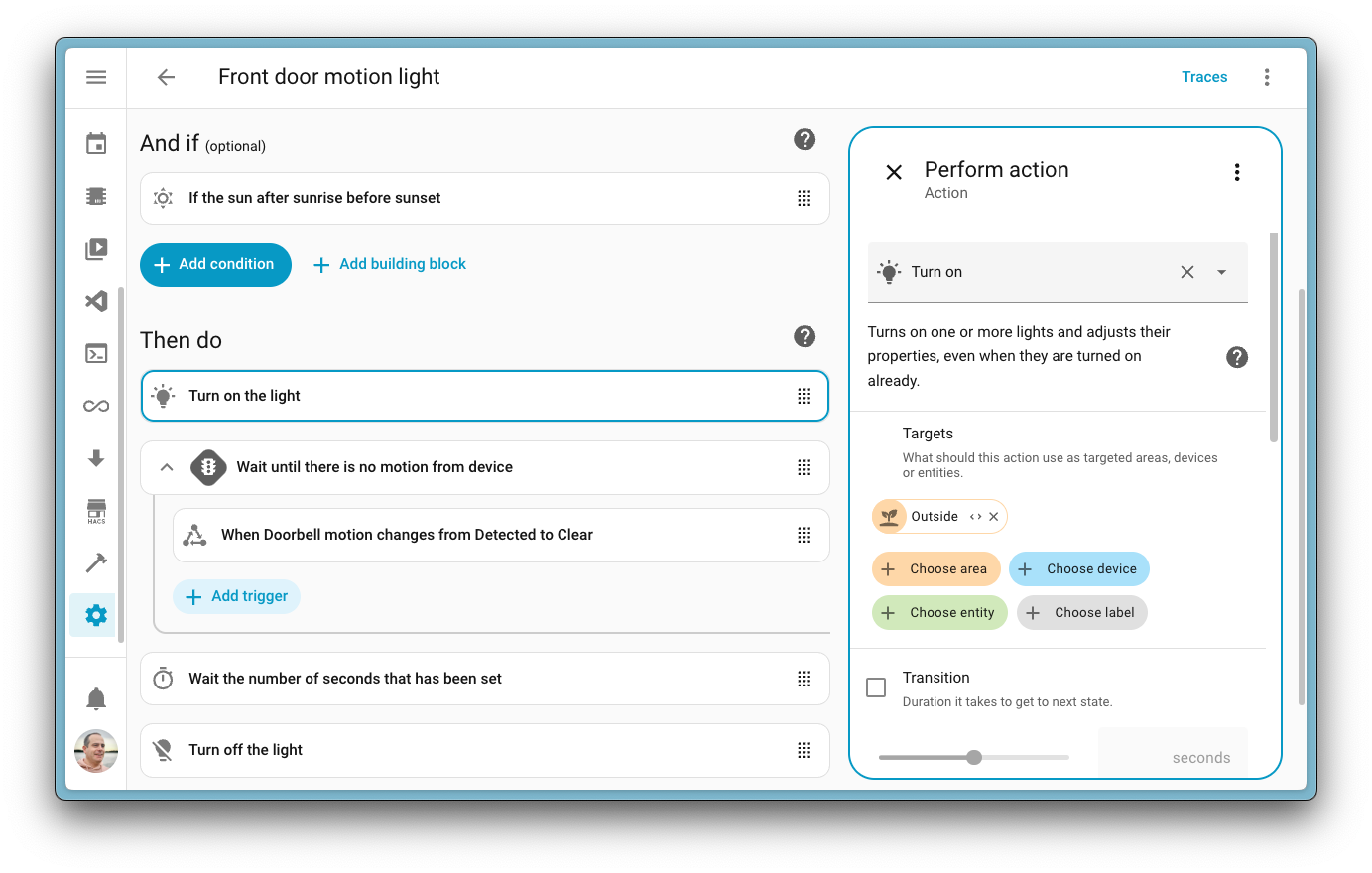
This allows you to keep an overview of your automation on the left side of your screen, while you can tweak its behavior on the right. Of course, we have thought of smaller screens as well. On mobile, instead of the sidebar, a sheet will pop up at the bottom of the screen. This pop-up is also resizable, making it easier than ever to edit an action while reviewing your triggers.
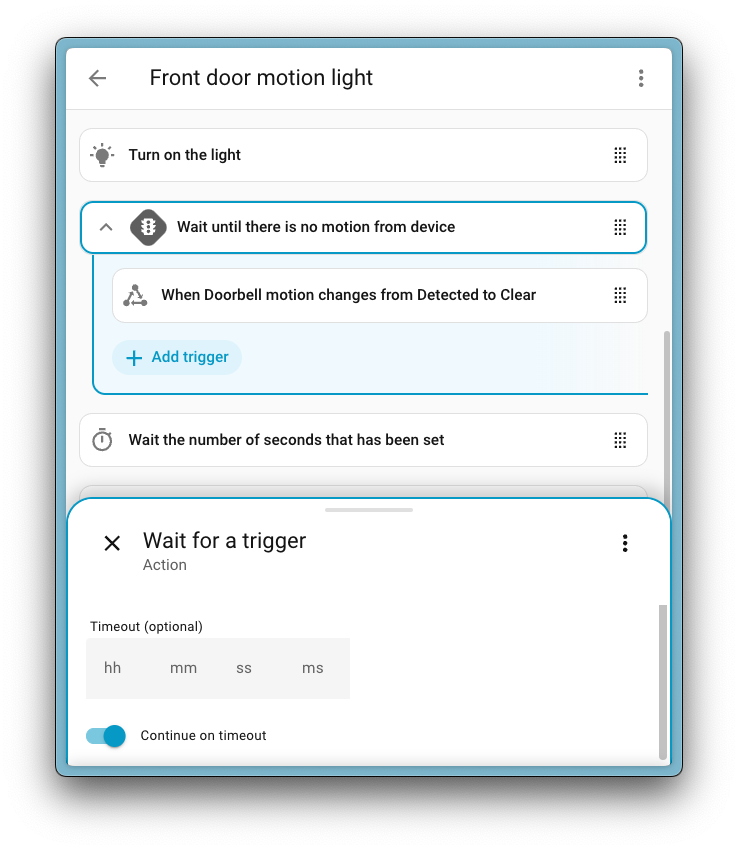
Besides the sidebar, we have made tons of other little improvements as well. Tiny layout and styling changes that you will definitely notice as they really help with the overall readability. For example, small lines and borders around grouped elements have been added, making it easier to distinguish between different parts of your automation. Oh! And drag-and-drop support is now available on mobile! 🎉
One of Home Assistant’s greatest strengths is our community. We’re building the changes to our automations together, and your input will shape where it goes next. There are two ways to get involved:
Introducing the Home dashboard
Over the past year, we have focused on dashboards and their capabilities a lot. We’ve looked at a lot of your dashboards you’ve shared on socials, and talked to many of you about how you organize all your smart home devices and services. The goal? Making dashboards faster and easier to create, while still making them very customizable.
With this release, we’re introducing a brand-new Home dashboard. The purpose is simple: to give you easy access to the right information at the right time.
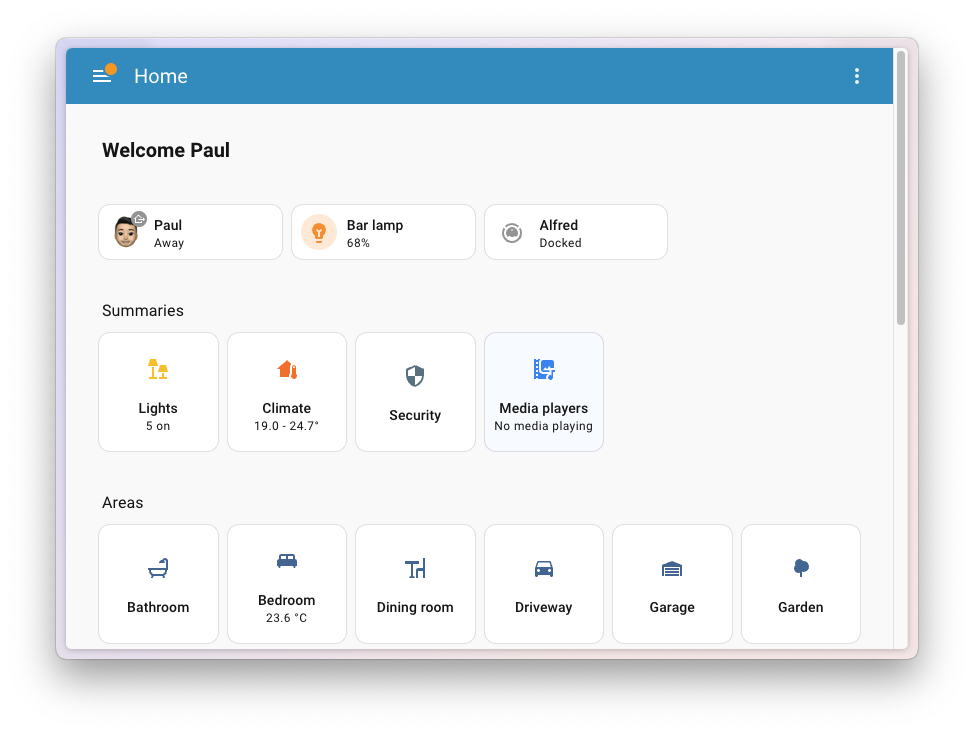
The dashboard adapts to your Home Assistant experience level: powerful enough for advanced users, yet approachable for newcomers. We’re working to have it earn its name, and hope it will eventually become your new Home page. As always, it’s optional; you can always pick your own dashboard. This is the first iteration, and we’ll continue developing it in the open.
When you first open the Home dashboard, it gives you a quick way to navigate to useful summaries for your light, climate, security, and media devices. You can also browse by areas, getting an overview of all the devices and services associated with that part of your home.
We’re also introducing Favorites. You can pin any entity to the top, whether it’s a light, climate, or a person. We’d love to see what you choose (more on this in the future).
The Home dashboard is not just about quick control. It also brings insights and information about your home. This first release includes weather and energy cards. It’s a simple start, and we have a lot of ideas to explore with you. For example, helping you create your first automation, or show discovered devices.
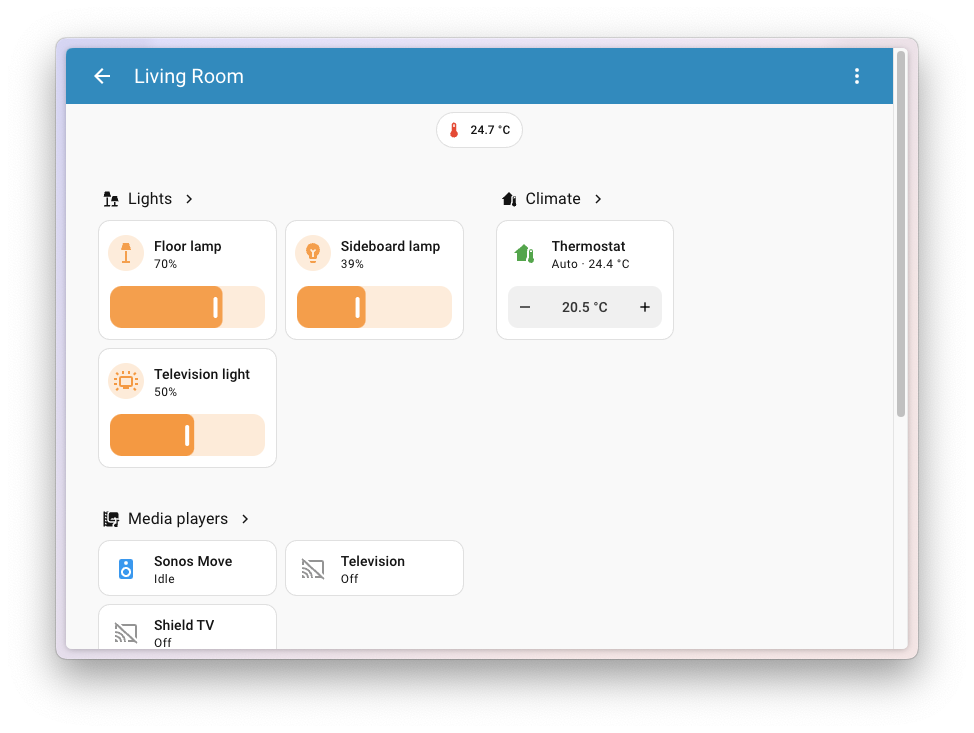
For now, the Home dashboard is considered experimental. Configuration options are limited, and it’s guaranteed to evolve. It won’t appear automatically, and if you want to try it you’ll need to add it manually in the dashboard settings, by adding a new “Home” dashboard.
One of Home Assistant’s greatest strengths is our community. We’re building this dashboard together, and your input will shape where it goes next. There are two ways to get involved:
New tile card features
The tile card is the most versatile card we have in our arsenal of cards for our dashboards.
One superpower of the tile card is its “features”, which are small additions where you can add quick interactions to these cards. For example, a slider to control the brightness of a light or buttons for the speed presets of a fan. Features have been extended quite a bit in this release by a dedicated group of community members.
Trend chart
This release, an absolute banger is the addition of the trend chart features for tile cards created by @MindFreeze
This feature adds a handy quick graph to the tile card, showing the history of a specific entity over time. For this initial version, the time window shown is 24 hours.
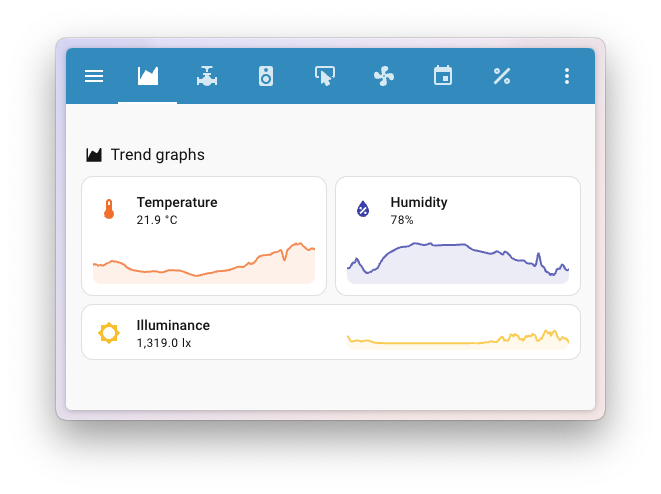
Media player controls
@timmo001

Bar gauge
A new tile card feature, made by @MindFreeze
For this initial version, it works with sensors that use a percentage (%) for their unit of measurement.
This makes the card great, for example, for a battery overview dashboard. Nice work!

Fan direction and oscillation controls
Thanks to @pcan08
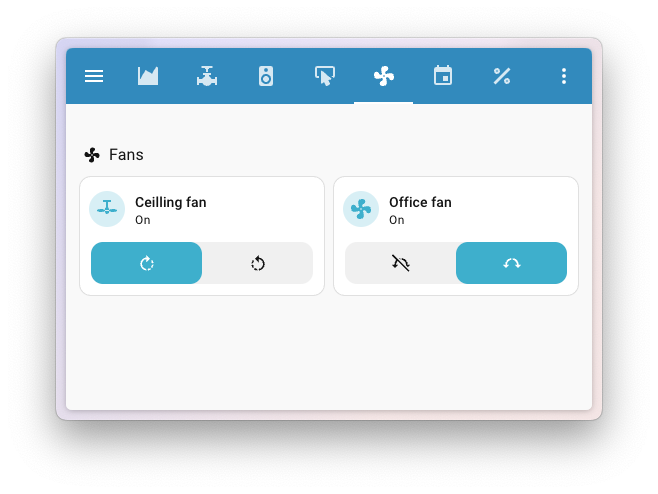
Buttons
Thanks to @dhoeben
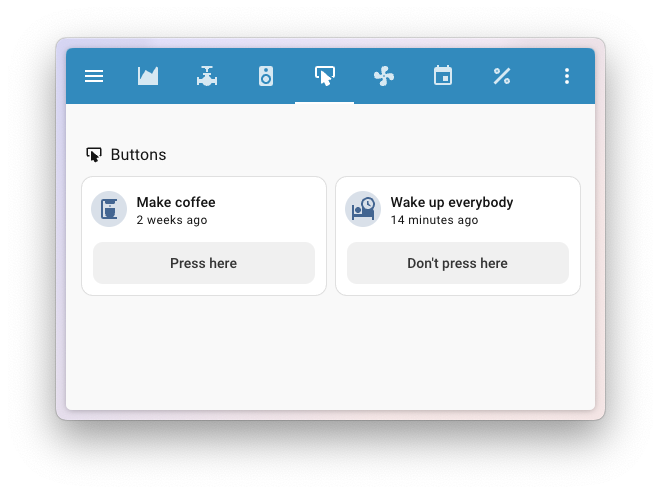
Valve open/close and position controls
Thanks to @timmo001
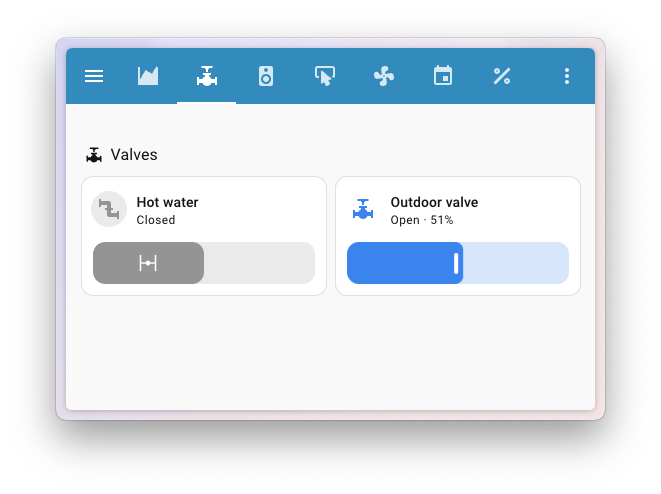
Setting the date
@timmo001
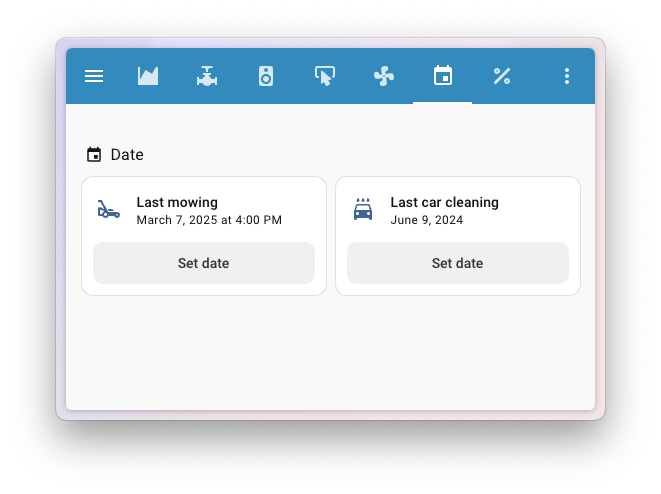
Integrations
Thanks to our community for keeping pace with the new integrationsIntegrations connect and integrate Home Assistant with your devices, services, and more. [Learn more] and improvements to existing ones! You’re all awesome 🥰
New integrations
We welcome the following new integrations in this release:
-
Aladdin Connect, added by @swcloudgenie
Control and monitor your Genie Aladdin Connect garage doorsdirectly from Home Assistant. -
SEKO PoolDose, added by @lmaertin
Integrate your SEKOwater treatment system of your pool or spa to monitor temperature and chemical levels. -
Sleep as Android, added by @tr4nt0r
Connects the Sleep as Android appto Home Assistant, allowing you to trigger automations based on alarm clock or sleep cycle events. -
ToGrill Bluetooth BBQ thermometers, added by @elupus
Connect your ToGrill-compatible Bluetooth grill thermometer and monitor your BBQ efforts to cook steaks to absolute perfection.
Noteworthy improvements to existing integrations
It is not just new integrationsIntegrations connect and integrate Home Assistant with your devices, services, and more. [Learn more] that have been added; existing integrations are also being constantly improved. Here are some of the noteworthy changes to existing integrations:
-
Husqvarna Automower got some nice additions from @Thomas55555
! You can now reset cutting blade usage time and track error events with a new event entity. Perfect for keeping track of your lawn mowing robot! - The Reolink integration now includes speak and doorbell volume controls, plus a chime silent time number entity! Nice @starkillerOG
! - You can now send notifications with the PlayStation Network integration! Send direct messages to your friends! Thanks, @tr4nt0r
! - Network admins will love @Tomeroeni
bringing individual (enable/disable) switch port control to UniFi switches! - The OpenWeatherMap integration now includes a wind gust sensor, thanks to @gjohansson-ST
! -
@kizovinh
added support for battery status and online status sensors to the EZVIZ integration, making it easier to monitor your EZVIZ cameras. Nice! - If you own a Russound RIO device, you can now browse your device’s saved presets directly from the media browser! Thanks, @noahhusby
! -
@mbo18
added an absolute humidity sensor to the Awair integration. Nice! - The Teslemetry integration added charging and preconditioning actions for your Tesla vehicle. Thanks, @Bre77
! -
@catsmanac
added IQ Meter Collar and C6 Combiner support to the Enphase Envoy integration. Good work!
Integration quality scale achievements
One thing we are incredibly proud of in Home Assistant is our integration quality scale. This scale helps us and our contributors to ensure integrations are of high quality, maintainable, and provide the best possible user experience.
This release, we celebrate several integrationsIntegrations connect and integrate Home Assistant with your devices, services, and more. [Learn more] that have improved their quality scale:
-
2 integrations reached platinum 🏆
-
Network UPS Tools (NUT), thanks to @tdfountain
-
Uptime Kuma, thanks to @tr4nt0r
-
Network UPS Tools (NUT), thanks to @tdfountain
-
1 integration reached bronze 🥉
-
Mastodon, thanks to @andrew-codechimp
-
Mastodon, thanks to @andrew-codechimp
This is a huge achievement for these integrations and their maintainers. The effort and dedication required to reach these quality levels is significant, as it involves extensive testing, documentation, error handling, and often complete rewrites of parts of the integration.
A big thank you to all the contributors involved! 👏
Now available to set up from the UI
While most integrationsIntegrations connect and integrate Home Assistant with your devices, services, and more. [Learn more] can be set up directly from the Home Assistant user interface, some were only available using YAML configuration. We keep moving more integrations to the UI, making them more accessible for everyone to set up and use.
The following integration is now available via the Home Assistant UI:
Farewell to the following
The following integrationIntegrations connect and integrate Home Assistant with your devices, services, and more. [Learn more] is no longer available as of this release:
- Uonet+ Vulcan has been removed. Vulcan has changed their API and their policies forbid using the API from unofficial software.
Other noteworthy changes
There are many more improvements in this release; here are some of the other noteworthy changes:
- Based on feature requests from the community, all modern template entity syntax now supports setting a default entity ID directly in YAML. Thanks @Petro31
for implementing that! -
@Petro31
also added support for two new entity types to the template integration. You can now create your own templated event entities and update entities. Awesome! - Home Assistant now supports
m³/minas a volume flow rate unit. Nice addition @fetzerch! - Our voice guy @synesthesiam
has been busy with some great QoL improvements this release as well. - The intent handling for the default agent (non-LLM) now supports fuzzy matching. The technique ensures voice pipelines recognize many more sentences. This improvement is available for English only, while we are looking for ways to extend this to other languages.
- We now have built-in intents to control the volume of (active) media players! Like the song? Just ask Home Assistant to turn it up a notch!
- After all that dancing, you might have gotten a little warm. Hence in this release, we now also have intents to control fan speeds. Nice!
Analog clock
In Home Assistant 2025.4, we introduced the clock card, which provides a digital clock display for your dashboards.
For this release, @timmo001
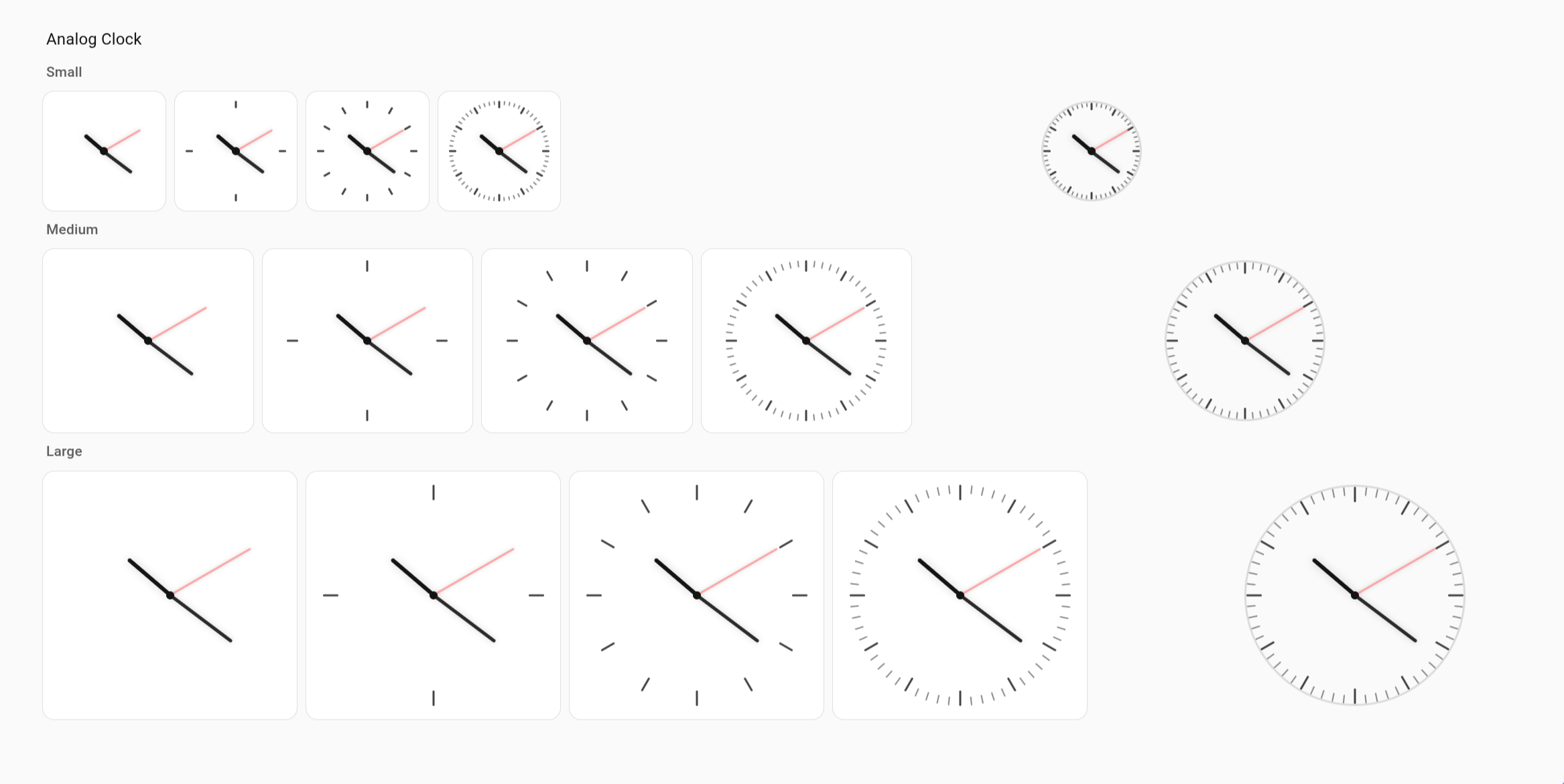
Storage insights
Disk almost full? You might wonder where your storage space has gone…
This release adds disk metrics to the storage configuration panel, letting you see usage at a glance, helping you identify what is taking up space.
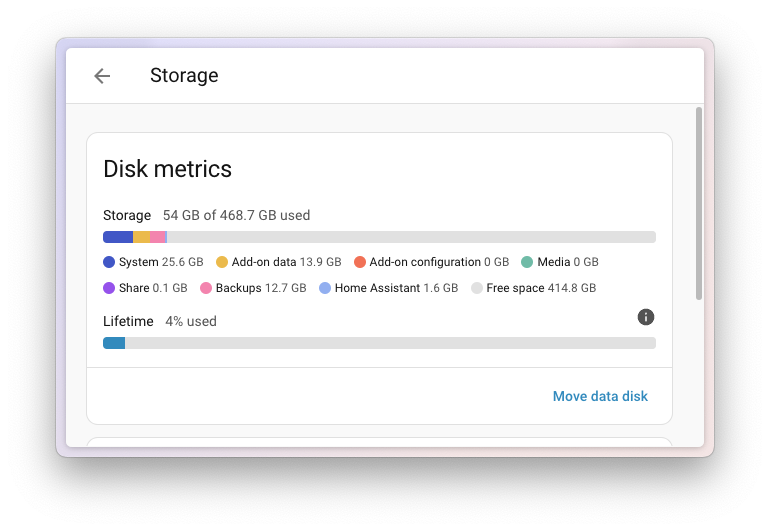
You can find these metrics by navigating to Settings > System > Storage, or by selecting the My Home Assistant button down below.
Patch releases
We will also release patch releases for Home Assistant 2025.9 in September. These patch releases only contain bug fixes. Our goal is to release a patch release once a week, aiming for Friday.
2025.9.1 - September 5
- Add support for migrated Hue bridge (@marcelveldt
- #151411 ) - Add missing device trigger duration localizations (@karwosts
- #151578 ) - Correct capitalization of “FRITZ!Box” in FRITZ!Box Tools integration (@tr4nt0r
- #151637 ) - Fix Sonos Dialog Select type conversion (@PeteRager
- #151649 ) - Fix WebSocket proxy for add-ons not forwarding ping/pong frame data (@felipecrs
- #151654 ) - Fix, entities stay unavailable after timeout error, Imeon inverter integration (@Imeon-Energy
- #151671 ) - Bump aiohue to 4.7.5 (@marcelveldt
- #151684 ) - Update frontend to 20250903.3 (@bramkragten
- #151694 ) - Require OhmeAdvancedSettingsCoordinator to run regardless of entities (@dan-r
- #151701 ) - Bump ohmepy version to 1.5.2 (@dan-r
- #151707 ) - Update Mill library 0.13.1 (@Danielhiversen
- #151712 ) - Handle match failures in intent HTTP API (@synesthesiam
- #151726 ) - Bump pyschlage to 2025.9.0 (@dknowles2
- #151731 ) - Bump bimmer_connected to 0.17.3 (@rikroe
- #151756 ) - Fix recognition of entity names in default agent with interpunction (@arturpragacz
- #151759 ) - Fix enable/disable entity in modbus (@janiversen
- #151626 )
2025.9.2 - September 12
- Fix XMPP not working with non-TLS servers (@Human
- #150957 ) - Update SharkIQ authentication method (@funkybunch
- #151046 ) - Add event entity on websocket ready in Husqvarna Automower (@Thomas55555
- #151428 ) - Fix Aladdin Connect state not updating (@hbludworth
- #151652 ) - Fix support for Ecowitt soil moisture sensors (@blotus
- #151685 ) - Fix update of the entity ID does not clean up an old restored state (@jbouwh
- #151696 ) - Revert “Jewish Calendar add coordinator “ (@tsvi
- #151780 ) - Remove device class for Matter NitrogenDioxideSensor (@lboue
- #151782 ) - Improve config entry migration for edge cases in Alexa Devices (@chemelli74
- #151788 ) - Bump habluetooth to 5.3.1 (@bdraco
- #151803 ) - Fix KNX BinarySensor config_store data (@farmio
- #151808 ) - Fix KNX Light - individual color initialisation from UI config (@farmio
- #151815 ) - Mark Tractive switches as unavailable when tacker is in the enegy saving zone (@bieniu
- #151817 ) - Allow delay > 1 in modbus. (@janiversen
- #151832 ) - max_temp / min_temp in modbus light could only be int, otherwise an assert was provoked. (@janiversen
- #151833 ) - removed assert fron entity in modbus. (@janiversen
- #151834 ) - Bump pydrawise to 2025.9.0 (@dknowles2
- #151842 ) - Bump aioharmony to 0.5.3 (@bdraco
- #151853 ) - Update pysmarty2 to 0.10.3 (@martinssipenko
- #151855 ) - fix rain sensor for Velux GPU windows (@wollew
- #151857 ) - Bump aioecowitt to 2025.9.1 (@edenhaus
- #151859 ) - Use
native_visibilityproperty instead ofvisibilityfor OpenWeatherMap weather entity (@bieniu- #151867 ) - Bump aiontfy to v0.5.5 (@tr4nt0r
- #151869 ) - Bump aiolifx-themes to 1.0.2 to support newer LIFX devices (@Djelibeybi
- #151898 ) - Bump aiovodafone to 1.2.1 (@chemelli74
- #151901 ) - Avoid cleanup/recreate of device_trackers not linked to a device for Vodafone Station (@chemelli74
- #151904 ) - Fix _is_valid_suggested_unit in sensor platform (@epenet
- #151912 ) - Bump habluetooth to 5.5.1 (@bdraco
- #151921 ) - Bump bleak-esphome to 3.3.0 (@bdraco
- #151922 ) - Bump habluetooth to 5.6.0 (@bdraco
- #151942 ) - Fix invalid logger in Tuya (@epenet
- #151957 ) - Fix for squeezebox track content_type (@peteS-UK
- #151963 ) - Fix playlist media_class_filter in search_media for squeezebox (@peteS-UK
- #151973 ) - Bump habluetooth to 5.6.2 (@bdraco
- #151985 ) - Bump yt-dlp to 2025.09.05 (@joostlek
- #152006 ) - Bump
accuweatherto version 4.2.1 (@bieniu- #152029 ) - Fix HomeKit Controller stale values at startup (@bdraco
- #152086 ) - Fix duplicated IP port usage in Govee Light Local (@abmantis
- #152087 ) - Fix DoorBird being updated with wrong IP addresses during discovery (@bdraco
- #152088 ) - Fix supported _color_modes attribute not set for on/off MQTT JSON light (@jbouwh
- #152126 ) - Fix reauth for Alexa Devices (@chemelli74
- #152128 ) - Bump hass-nabucasa from 1.1.0 to 1.1.1 (@ludeeus
- #152147 ) - Update frontend to 20250903.5 (@bramkragten
- #152170 ) - Use position percentage for closed status in Velux (@wollew
- #151679 )
2025.9.3 - September 13
2025.9.4 - September 19
- Bump habiticalib to v0.4.4 (@tr4nt0r
- #151332 ) - Bump habiticalib to v0.4.5 (@tr4nt0r
- #151720 ) - Fix bug with the hardcoded configuration_url (asuswrt) (@Vaskivskyi
- #151858 ) - Fix HomeKit Controller overwhelming resource-limited devices by batching characteristic polling (@bdraco
- #152209 ) - Upgrade waterfurnace to 1.2.0 (@sdague
- #152241 ) - Bump aiohomekit to 3.2.16 (@bdraco
- #152255 ) - Bump bluetooth-auto-recovery to 1.5.3 (@bdraco
- #152256 ) - Add proper error handling for /actions endpoint for miele (@astrandb
- #152290 ) - Bump aiohomekit to 3.2.17 (@bdraco
- #152297 ) - Update authorization server to prefer absolute urls (@allenporter
- #152313 ) - Bump imeon_inverter_api to 0.4.0 (@Imeon-Energy
- #152351 ) - Bump pylamarzocco to 2.1.0 (@zweckj
- #152364 ) - Add La Marzocco specific client headers (@zweckj
- #152419 ) - Fix KNX UI schema missing DPT (@farmio
- #152430 ) - Bump pyemoncms to 0.1.3 (@alexandrecuer
- #152436 ) - Fix Sonos set_volume float precision issue (@PeteRager
- #152493 ) - Bump opower to 0.15.5 (@tronikos
- #152531 ) - Bump holidays to 0.80 (@gjohansson-ST
- #152306 ) - Bump holidays to 0.81 (@gjohansson-ST
- #152569 ) - Bump asusrouter to 1.21.0 (@Vaskivskyi
- #151607 )
Need help? Join the community!
Home Assistant has a great community of users who are all more than willing to help each other out. So, join us!
Our very active Discord chat server is an excellent place to be, and don’t forget to join our amazing forums.
Found a bug or issue? Please report it in our issue tracker
Are you more into email? Sign up for the Open Home Foundation Newsletter to get the latest news about features, things happening in our community, and other projects that support the Open Home straight into your inbox.
Backward-incompatible changes
We do our best to avoid making changes to existing functionality that might unexpectedly impact your Home Assistant installation. Unfortunately, sometimes, it is inevitable.
We always make sure to document these changes to make the transition as easy as possible for you. This release has the following backward-incompatible changes:
Encoding units containing the μ character
The encoding for some units that contain the μ character has been changed. Users that consume state data from sensors that have changed units will be impacted (such as exported state data to InfluxDB). The units with a changed encoding are:
-
μSv/hfor thearanetintegration as a unit for radiation rate -
μS/cmforUnitOfConductivity.MICROSIEMENS_PER_CM -
μVforUnitOfElectricPotential.MICROVOLT -
μg/ft³for concentration in micrograms per cubic foot -
μg/m³for concentration in micrograms per cubic meter -
μmol/s⋅m²for thefytaintegration as a unit for light -
μgforUnitOfMass.MICROGRAMS -
μsforUnitOfTime.MICROSECONDS
1-Wire
The raw_value attribute was previously deprecated and has now been removed.
Alexa Devices
The sound list has been updated to match the one used by the Alexa Mobile app.
The variant parameter is no longer required.
Check your automations to ensure the selected sound is still present.
(@chemelli74
Husqvarna Automower BLE
The integration now requires the Automower PIN when being set up. This ensures Home Assistant can communicate with more models of mowers and with higher security levels.
(@alistair23
KNX
KNX scene entities now also change their state when a scene was activated externally (from bus). Previously they only updated when activated from within Home Assistant.
(@farmio
SIA Alarm Systems
SIA alarm status code CF (armed with malfunctions) is now mapped to armed_away instead of to armed_custom_bypass.
(@etnoy
SwitchBot Bluetooth
The battery property on vacuum entities is being removed in Home Assistant. Therefore, this property is now removed from this integration and is replaced by a battery level sensor.
Please review your automations, scripts, and dashboards using the battery property and update the code to use the battery sensor instead.
Yale August
The August integration now uses OAuth authentication with Yale August’s official API. This is a required one-time breaking change as the unofficial authentication method will stop working soon. This migration helps reduce unnecessary load on Yale August’s servers while ensuring continued access for all users.
When you update Home Assistant, you’ll be prompted to re-authenticate your August account:
- Select the notification or go to Settings → Devices & services → August
- Select “Reconfigure” and follow the OAuth flow to sign in
- Once authenticated, your devices will work exactly as before
We’re grateful to Yale August for officially supporting Home Assistant with dedicated API access!
(@bdraco
If you are a custom integration developer and want to learn about changes and new features available for your integration: Be sure to follow our developer blog. The following changes are the most notable for this release:
- Standardize encoding of μ in units of measurement
- The DeviceEntry.suggested_area attribute is deprecated and will be removed
All changes
Of course, there is a lot more in this release. You can find a list of all changes made here: Full changelog for Home Assistant Core 2025.9